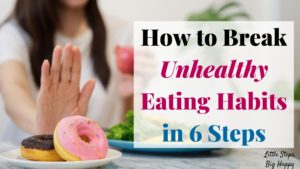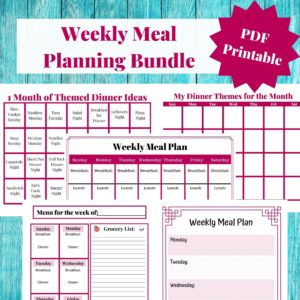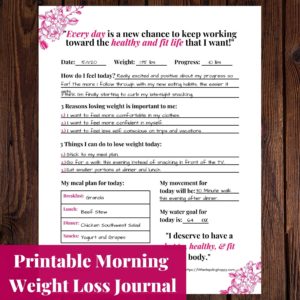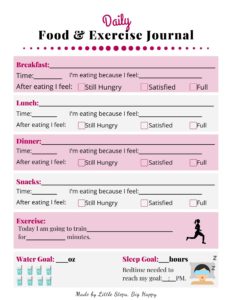For most women who are trying to lose weight, it can be common to ask yourself “Am I eating too much?” (I sure did!) In this article, I’m going to tackle the topic of overeating vs. satisfied and how to tell if you’re overeating.
Learning to stop overeating can help you lose weight, improve your overall health, and learn to develop a better relationship with food. It’s the number one skill I learned that helped me reach my weight loss goals and stay there for over 2 years.
Of all the things I have learned about eating healthy without being miserable, this is what has helped me the most. If you want to get in shape without having to give up all your favorite foods then it’s very important to learn how to stop overeating.

Disclosure: This post may contain affiliate links which I’m happy to promote. All thoughts and opinions are my own. Much love & thank you for your support. 
Contents
Why Do You Need to Stop Eating When Satisfied, Not Full?
Understanding the difference between overeating vs. satisfied is a huge part of developing a healthy relationship with food. It’s key in learning how to eat what your body needs for fuel and energy without eating too much.
What it all boils down to is that eating until we feel full is actually overeating. So many of us were taught growing up that you’re supposed to eat until you can’t eat anymore.
But in reality, that’s eating more than our bodies need. Our bodies are then forced to store the extra calories we consume as fat.
After years of practicing eating until full, a few kids, and a metabolism that slows as we age, the next thing we know we’re hiding behind our kids in pictures and dreading the idea of anyone seeing us in a bathing suit.
It’s important to understand how continuing to eat until full instead of satisfied affects our bodies.
Consequences of eating until full.
Weight Gain
The number one and most common consequence to eating until full instead of satisfied is weight gain. In an article on Healthline, registered dietician Jillian Kubala wrote that ” Overeating remains a prominent cause of weight gain. If you take in more calories than you burn per day, you’ll likely gain weight.”
This doesn’t come as a surprise to most of us, but it’s an important reminder. Eating until full is overeating and it leads to excess weight gain.
It develops an unhealthy relationship with food.
One of the most shocking things I experienced when I started practicing eating until satisfied was how hard it was to do. I had been eating until I was “full” for years.
And not only had it become a habit, but I had wrapped all kinds of meaning around the sensation. Being “full” meant comfort, relaxation, and relief from stress.
This meant that anytime I was tired, stressed, cranky, or irritated, I turned to food to feel better. I was using emotional eating to solve my problems.
Learning to overcome this has been challenging and it remains my biggest struggle when it comes to eating a healthy diet and maintaining my weight loss.
Overall, overeating and eating until “full” have played a big part in creating unhealthy eating habits I have had to overcome when trying to lose weight and get in shape.
[convertkit form=973439]
Am I Full Or Satisfied?
Learning to tell the difference between overeating vs. satsified is talked about often in intuitive eating, but it’s not covered much in traditional dieting culture.
Most diets will have you counting points, macros, calories, or some other number to help you focus on not overeating. They provide you with specific recipes or meal plans.
All of which is helpful, but it doesn’t psychologically teach you how to stop wanting to overeat. You don’t learn how to not crave the sensation of wanting to eat until you feel full.
It’s why most of us struggle to stick with traditional diets and often gain the weight back when we fail at them. Once you understand what it means to stop at satisfied instead of full, everything about eating a healthy diet and not overeating becomes a whole lot easier.
Let’s cover some common questions about eating until satisfied vs. full.
What is the feeling of fullness and satisfaction after a meal?
If you’re unfamiliar with the idea of eating until satisfied, it might sound a little weird or vague. It certainly did when I first heard it.
There are also several different definitions when it comes to eating until satisfied.
Rachael Hartley, a registered dietitian, explains: “Fullness is the physical sensation of satiety, while satisfaction is the mental sensation of satiety.”
Leanna Skarnulis from WebMD talks about satiety and describes it as “…a diet and nutrition buzzword for the state of feeling full…”
She goes on to talk about how different foods have different satiety levels. Meaning some foods will help us feel full/satisfied/ready to stop eating sooner than others.
And, no surprise, healthier foods tend to cause us to feel satisfied sooner than junk food. I have seen this play out time and time again in my own life.
I’m only going to eat so many carrots, but I could eat an entire box of Cheez-its and still go back for more.
For my own weight loss journey and what I teach my clients, I use this definition:
Eating to satsified means eating until you’re no longer physically hungry.
Here are some signs I use to help me recognize when I’m satisfied:
- I’m no longer physically hungry.
- I start to get distracted from my food.
- Healthy food is no longer appealing.
- I can get up and go for a brisk walk if needed.
- I start taking long breaks between bites.
- Between bites I sigh.
- I start getting picky about which bites I want to eat next.
Why do I feel full but not satisfied?
As mentioned above, there is a difference between feeling full and feeling satisfied. Most of us feel “full” when we can no longer fit any more food into our bodies.
We physically can’t eat anymore or we start to feel like we would be uncomfortable if we did. However, this doesn’t always equate to a traditional feeling of “satisfied.”
Most of us equate satisfaction with feeling mentally satiated. For example, even after eating a full meal and feeling physically full, we will often crave something sweet.
That craving for something sweet is purely mental and when we don’t give in to it, we often feel unsatisfied with our meal.
Learning to identify and redirect the mental cravings for food is an important part of successfully losing weight. But it doesn’t have to be an all-or-nothing scenario.
You don’t have to focus only on feeling physically satisfied and completely ignore being mentally satisfied with your eating decisions.
A healthy relationship with food often means understanding and, when appropriate, satisfying both the physical and mental feelings of satiety without overeating.
Here is an example:
A few times a week I have nights where I plan an extra sweet treat. On those days I serve myself a smaller portion of dinner.
Instead of a full bowl of stir-fry, I might only fill up my bowl about 3/4 of my normal portion size. That leaves room to add in a few cookies.
I satisfy my physical hunger with something healthy and nutritious while saving a little bit of room to satisfy my mental craving for something sweet without overeating.
[convertkit form=973439]
Overeating vs. Satisfied: How to Tell if You’re Eating Too Much
Now that we understand what we’re aiming for when we talk about overeating vs. satisfied, let’s dive into how to tell when you’ve eaten too much. I’m going to share with you some common signs that help you tell if you’ve gone past satisfied and are starting to creep into full, or even overfull.
These are things to look for during or after your meal to indicate that you’re eating past what your body needs.
You feel uncomfortable when you finish eating.
One very simple and easy way to tell if you’ve eaten too much is how you feel once you’re done. If you feel uncomfortable, it’s a good sign that you’ve gone well past satisfied.
Often you might feel bloated, stuffed, or overly full. In the past, this is about the time where I feel the need to unbutton my pants or like I need to sit back to give my belly room.
Your body has physically become uncomfortable because you’ve put so much food in your stomach it has to stretch past its normal capacity to contain it.
It might sound obvious when explained that this is a sign of overeating, but most of us often overlook it. We become so fixed on the way the food tastes or whatever caused us to start eating in the first place we miss this very obvious sign of overeating.
Your stomach hurts.
Another good sign to look for when checking if you’re overeating vs. satisfied is if your stomach hurts when you finish eating. At this point, you have gone past discomfort and settled into actual pain.
Your body is working so hard to contain and process the amount of food you’ve eaten that it starts to hurt.
I vividly remember experiencing this after more than one Thanksgiving meal. On those days I would eat far more than my body could handle and I would get a stomach ache later.
If you are used to ignoring the first sign of discomfort, then often this may be the clue that tells you it’s time to stop eating. In reality, this is a very late sign of overeating.
To eat for weight loss, maintenance, or for your body’s energy needs, you have to stop long before your stomach starts to hurt.
You feel like you could keep eating even though you ate plenty.
Another sign that you’re overeating is when you feel like you could keep eating despite having already eaten plenty of food. This is a good sign that you’re being triggered to eat for emotional reasons instead of physical hunger.
Most often this shows up during times of stress or habitual snacking. For example, I’ve caught myself doing this a lot during stressful times of the day or late in the evening when I’m looking to relax.
I go get a snack. And then another. And a little while later, another one. By the time I catch myself, I’ve eaten a few bagels, some chips, a sandwich, a banana, 5 cookies, and I still feel the urge to eat.
I spread my eating out enough that I never feel discomfort or pain and instead, I’m constantly searching for that “fullness” feeling.
This is always a red flag in my mind that I’m overeating. I’m chasing the sensation of eating and completely ignoring whether my body is physically hungry.
That type of behavior always leads to blowing way past satisfied and eating more food than my body needs.
You feel lethargic.
Another good sign to look for when it comes to overeating vs. satisfied is if you feel lethargic after your meal. In an article on Medical News Today, reviewed by Ph.D. Deborah Weatherspoon, the author Alison Fisher states that:
A person may be likelier to experience postprandial somnolence [a state of drowsiness or lassitude following a meal] after a large meal. People who eat larger lunches may experience more of an afternoon slump than those who eat less at midday. Eating causes blood sugar to rise, and a dip in energy may follow.
Overeating can often cause your body to spend tremendous energy trying to process all the food you’ve eaten. I remember more than one occasion where, after eating too much, all I felt up for was sitting on the couch and watching tv or maybe taking a nap.
This is a clear sign that you’ve gone past satisfied and have eaten too much.
You’re only eating because it tastes good.
Another sign to look for with overeating vs. satisfied is if you’re eating just because the food tastes good. Remember in our definition above, eating until satisfied means stopping when you’re body is no longer hungry.
If you’re eating only because it tastes good, you are definitely eating past satisfied. An example of this would be similar to the dinner and dessert situation I mentioned before.
If you eat until you’re full at dinner, but then you decide to eat dessert as well because you’re craving something sweet, you’re overeating. This isn’t to say that you can never eat dessert, but you need to balance how much dinner and dessert you eat with how much food your body needs to feel satisfied.
Simply eating less dinner so that you have room for dessert without overeating will help you enjoy your food without having to eat past satisfied.
Related Posts:
- Emotional Overeating: How to recognize it & how to stop it!
- How to Break Unhealthy Eating Habits in 6 Steps
[convertkit form=973439]
How to Stop Eating When Satisfied
In the battle against overeating, understanding the difference between overeating vs. satisfied is the first step. Next is learning how to stop eating when satisfied.
Practicing this skill has helped me to lose weight, beat emotional eating, and have a healthy relationship with food. It’s the key to managing overeating without having to count calories, give up your favorite foods, and be miserable while losing weight.
Here are some tips and tricks that I have used to get better at stopping when satisfied.
Remember it’s not your “last meal.”
A good tip to help you stop eating when satisfied is to recognize that whatever your eating isn’t the last time you will be able to eat it. One of the reasons I had such a hard time not overeating at Thanksgiving is because I would think about how I only got to eat this food once a year.
I felt like I had to eat every single bite I could because it would be another 365 days before I could have it again. But who said that has to be the case?
No law says I can’t cook myself a Thanksgiving meal every day of the year if I wanted. I was the only one putting that restriction on my diet.
In reality, all of us are in complete control of our eating decisions, but we treat so many meals like it’s the last time we’ll ever get to eat them.
Overeating on Thanksgiving is one thing, and if that was the only time I ever overate, I wouldn’t have had a weight problem.
But so many of us treat most of our meals like they are our “last meal.” We constantly eat like we don’t know when we will get to eat that food again.
Practical steps:
Here are some frequent thoughts we use to justify a “last meal” mentality:
- But it tastes so good.
- I don’t know when I’ll get to eat this again.
- This isn’t good for me and I shouldn’t be eating this. But since I am, I might as well eat it all.
- It’s a treat.
Whenever you recognize that you’re approaching being satisfied and it’s time to stop eating, some of these thoughts might pop into your head. They will encourage you to keep eating.
Instead, here are some thoughts to tell yourself instead:
- I can eat this again later when I’m hungry.
- This is not my only opportunity to eat this food.
- If it’s important to me to eat this food, I can plan to have it tomorrow.
These thoughts help distance yourself from the urgency of finishing the food right at that moment.
Eat when you’re hungry, not emotionally motivated.
Another step in learning to stop eating when satisfied is to make sure you only start eating when you’re physically hungry. Emotional eating is a gateway to overeating.
The only problem food fixes is hunger. So when we use it to help us feel better after a long day or to distract us when we’re bored or tired we reinforce the habit of eating when our body isn’t hungry.
The habit of eating because of our emotions instead of physical needs requires us to ignore the natural hunger and satiation cues our bodies send us. We end up focusing more on urges and cravings driven by our emotions.
This makes it ridiculously hard to tune back into our bodies when it’s time to stop eating.
Practical steps:
Here are some steps I take to check in with whether I’m eating because of hunger or my emotions:
1.) Ask myself, “Am I hungry?” If the answer is no, I ask myself, “What are you feeling right now?” (The answer is usually bored, tired, stressed, irritated, worn out, etc.)
Then I ask myself what else can I use to help me through this moment. If I’m bored, maybe I can read a book. If I’m tired, maybe a break on the couch.
I just make sure I look for a non-food solution to whatever emotion is coming up.
2.) If I’m not sure if I’m hungry, I ask myself, “Are you willing to eat the healthy food on your meal plan?” When the answer is no, I know it’s not real hunger and I ask myself, “What am I feeling right now?”
If the answer is yes, then I eat what I had planned.
Emotional cravings and urges can often disguise themselves as real hunger. But when your body is physically hungry, it’s willing to eat healthy and nutritious food.
If all you’re willing to eat is something sweet, sugary, or loaded with unhealthy carbs, odds are pretty good it’s an emotional craving.
Keep a food journal.
When learning the difference between overeating vs. satisfied it is very helpful to keep a food journal. Using a food journal helps you to plan and track your meals.
This can be instrumental in learning about your eating habits and behaviors. It also helps you to tune into your body’s hunger cues.
I like to use the food journal below.
It helps me track:
- What I’m eating.
- When I’m eating.
- Why I’m eating.
- How I feel when I’m done eating.
Filling out this journal helps remind me to check in with my body’s hunger cues as well as track important things like:
- How long I typically go between eating. An important indication for whether I’m waiting for physical hunger to eat.
- How much food I normally need to eat to feel satisfied. This helps me work on serving myself better portion sizes in the future.
- How much food I eat when I start to feel full. This helps me plan my meals better.
All of this information helps me recognize when I’m overeating so I can get better at stopping when I’m satisfied. You can grab the Daily Food & Exercise Journal Page from my resource library here.
Use the hunger scale.
Another good tool to help you stop eating when satisfied is to use a hunger scale. A hunger scale is a way to measure your physical hunger.
This can be really helpful for checking in with your body and deciding if you’re truly physically hungry enough to sit down and eat a meal. It’s also useful to help you decide at what point you should stop eating.
The hunger scale I first used when I learned to stop eating when satisfied looked like this:

The Hunger Scale:
- -4 I’m starving: This is when you’re so hungry you have to eat right now!
- -3 I’m really, really hungry: This is when you’ve gone past regular hunger and are probably starting to feel hangry.
- -2 I’m hungry: This is when you’re feeling regular physical hunger. It feels persistent, but not super urgent.
- -1 I’m a little hungry: This is when you’re starting to feel a little hungry, but you could wait a little longer if you needed to.
- 0 I’m neither hungry nor satisfied: This is when you are between hunger and satisfied. Physically you don’t need to eat, but you don’t feel particularly full either.
- +1 I’m almost satisfied: This is shortly before you get satisfied while eating or an hour or so after eating to satisfied.
- +2 I’m satisfied: This is when you’ve had enough to eat to physically satisfy your hunger.
- +3 I’m full: This is when you’ve overeaten a little and don’t want to eat anything else.
- +4 I’m completely stuffed: This is when you’ve eaten a lot and are starting to feel uncomfortable or sick.
When using this hunger scale, the goal is to try to stay between -2 and +2. That will ensure that you start to eat when physically hungry and stop when satisfied.
While learning to tune into your body’s hunger cues and needs, it’s normal to sometimes eat to a +3 or start eating at a -1. The more you practice though, the more you start to recognize physical hunger and eating to satisfied.
Practice mindful eating.
Another very powerful tool for mastering overeating vs. satisfied is to practice mindful eating. Mindful eating refers to paying attention to your food and the experience of eating.
This helps you focus on not overeating because it forces you to slow down and pay attention to your food and your body’s hunger and satiation cues.
This allows you to notice when you’re starting to feel full as well as helping you enjoy the actual flavors and experience of your food.
So often when we’re eating, we’re distracted and thinking about or doing something else. I have often sat down to eat my lunch while working at my desk.
The next thing I know, the food is gone and I don’t even remember tasting it. This makes it so much harder to stop when I’m satisfied.
Not only am I not even paying attention because I’m mindlessly eating, but I’ve also missed all the flavors and textures of my food. This makes me much more likely to keep eating because it tastes good.
Whenever I sit down and practice mindful eating, I actually get to experience my food. I pay attention to how it tastes. Which flavors and textures I like most.
I also start to notice when my attention has started to wander and I’m starting to hit satisfied. When I’m finally done, I’ve actually enjoyed my food and it’s a lot easier to move on with the rest of my day.
Here are some tips to help you practice mindful eating.
Eat without distractions
This first step in mindful eating is to eat without distractions. This means no phone, computer, text messages, social media, TV, or books.
All of these things will take your attention away from your food and your eating experience. This makes it harder to actually enjoy your food and notice when you’re starting to get close to satisfied.
It can be challenging the first few times you do this. You may struggle with feeling like you should be doing something else or just plain getting bored.
That’s when I remind myself that if I don’t focus on my food now, I will feel a need to eat more of it later to make up for it. I also remind myself it literally only takes me about 7-8 minutes to sit and eat my food.
Trying to focus for 7-8 minutes is well worth the effort to help easily maintain your weight and have a healthy relationship with food.
Pause between bites
Another useful tool for practicing mindful eating is to pause between bites. Eating too fast makes it really easy to overeat and blow right past satisfied.
Pausing between bites will allow your body enough time to start sending cues to your brain that you’re getting close to satisfied. A good tip to help you pause between bites is to set your silverware down between each bite.
You can also try taking a sip of water after each bite. Both of these methods will help eat at a slower pace.
This will also allow you to taste your food more as well as recognize when it’s time to stop eating.
Chew more
Another way to help practice mindful eating and recognize overeating vs. satisfied is to chew your food more. Just like pausing between bites, chewing more allows you to slow your entire eating experience down.
This helps to give your body and brain more time to recognize when you’re no longer physically hungry. A good way to start is to count how many times you usually chew when eating a bite of food. Then double that number.
Leave 2 bites behind
My favorite tool for practicing mindful eating is to leave 2 bites behind at every meal. Practicing this has made huge leaps in my ability to stop eating when I’m satisfied instead of full.
Growing up I was absolutely a member of the clean plate club. I was taught that I wasn’t done eating until my plate was empty.
As an adult, that trend continued so that I felt the need to finish all of my food regardless of whether I was satisfied, full, or stuffed.
This makes it very hard to stop eating when I’m satisfied if there is still food on my plate. To help with this, I started leaving 2 bites behind at every meal.
This helped for 2 reasons: 1.) I started getting used to seeing food still on my plate and being ok with walking away from it. 2.) It required me to slow down and pay attention to my meal.
It’s really hard to leave 2 bites behind when you’re mindlessly eating and focused on other things.
Practice, practice, practice!
Learning to recognize the difference between overeating vs. satisfied and when you’ve eaten too much takes practice. A lot of practice. A lot, a lot of practice.
I wish I could tell you it was as easy as reading this article and moving on with your life, but it’s not. It’s trial and error and learning to listen to your body’s hunger and satiation cues.
You will have days where you overeat a little and days where you overeat a lot. That’s an unfortunate, but normal part of the process.
But I will say that this method works! After 13 years of trying to lose weight off and on pretty unsuccessfully, I can tell you that this method is worth the effort to master.
Even in the beginning when I struggled to stop eating when I was satisfied for more than a meal or two a day I began to see immediate results with my weight loss. Continuing to practice this method has helped me lose the weight and keep it off for 2 years and going strong.
I’ve also developed a better relationship with food that allows me to prioritize healthy eating without feeling deprived of my favorite foods.
As you begin to adapt the methods I’ve covered in this article, keep in mind that it will take practice and a lot of it. But you will see results and it will get easier to do overtime.
[convertkit form=973439]
Conclusion to Overeating Vs. Satisfied
Now you know the difference between overeating vs. satisifed and how to tell if you’re eating too much. We have covered the difference between overeating, eating until full, and eating until satisfied.
We’ve also discussed signs to look for when you’re eating too much and we covered some useful tips and skills to practice to help you stop eating when satisfied instead of full. I hope this information helps you to reach your weight loss and health goals.
What are your thoughts on overeating vs. satisfied? How do you manage to avoid overeating? Let me know in the comments below or email me at Candice@littlestepsbighappy.com. Follow me on Pinterest for more healthy eating tips and advice.
Looking for more healthy eating tips?
Healthy Eating Habits:
- Emotional Overeating: how to recognize it and how to stop it
- How to Eat Healthy When Your Family Doesn’t: 8 Practical Tips
- How to Break Unhealthy Eating Habits in 6 Steps
- How to Stop Mindless Snacking
- Tips on How to Stop Late Night Eating
- 15 Quick and Easy Tips for Drinking More Water
- 7 Tips to Manage Food Cravings and Sustain Your Weight Loss
Dieting:
- 8 Secrets to a Successful Diet
- How to Stick to Your Diet on Vacation
- Does Counting Calories Work? – The Surprising Truth!
- 3 Ways You Practice Diet Sabotage & How to Stop!
- 21 Small Diet Changes to Lose Weight for Good
Pin this for later!!


You might also like…




I’m a busy mom of 3 turned Health and Fitness Coach and Self Defense Instructor. I help inspire other moms to reach their health, fitness, and weight loss goals. You can usually find me chasing my kiddos around, training Brazilian Jiu-Jitsu, or sneaking away to read romance novels. About Me





